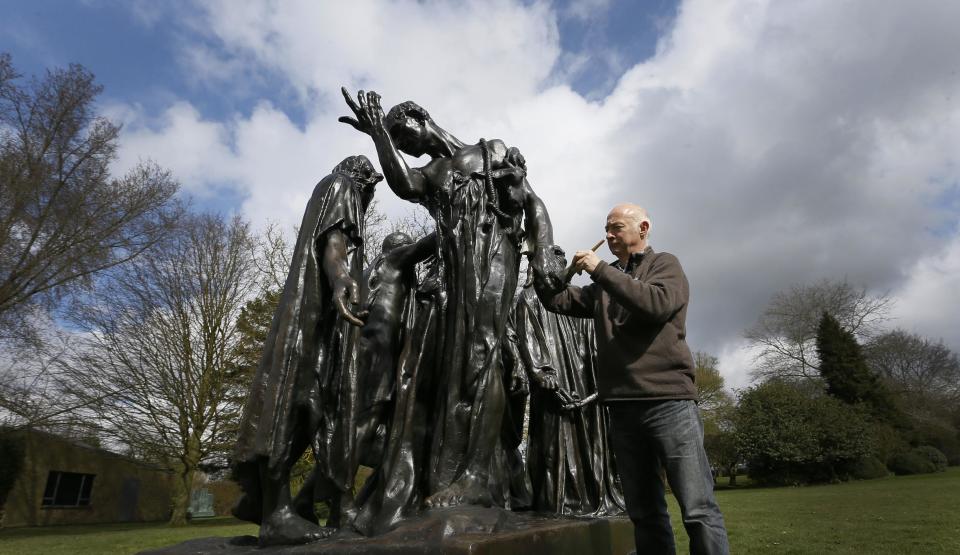Henry Moore, Auguste Rodin meet in English field
PERRY GREEN, England (AP) — Henry Moore has company on his muddy home turf.
At the late British artist's former home in the English countryside, swooping sculptures sit on rain-sodden fields, and sheep graze at the base of monumental bronzes. Now they have been joined by figures created by Auguste Rodin, for an exhibition that aims to tease out the connections between the French master sculptor and the English modernist.
The only problem, right now, is the weather. Britain's long, wet winter has left the countryside a soaking mess. Unlike most art shows, this one is best approached in waterproof boots.
"You've got water on the fields reflecting the forms, which is beautiful — but it's muddy," curator Anita Feldman said during a preview of the show on Tuesday. "But the lambs are out, which is beautiful."
The Henry Moore Foundation owns the house and farmland where the artist lived from the 1940s until his death in 1986. Set amid woods and fields about 30 miles (50 kilometers) north of London, it is a gallery and sculpture park devoted to the work of Moore, whose large, fluidly curved bronzes stand in 39 countries around the world.
"Moore Rodin," which opens March 29 and runs to Oct. 27, marks the first time the foundation has placed pieces by another artist alongside Moore's work on the lawns and fields.
The two artists never met; Moore was a 19-year-old soldier in World War I when Rodin died in 1917. But Moore Foundation Director Richard Calvocoressi said that between then they "reinvented the language of figurative sculpture."
Feldman acknowledged that people may not immediately see the connections between Moore — best known for massive abstracted forms — and Rodin, creator of "The Thinker" and other iconic human figures.
"The first thing people think of with Henry Moore is that it's weighty and static and timeless," she said Tuesday. "Whereas Rodin is all about movement and gesture."
Rodin's muscular nudes are more obviously classical in inspiration than Moore's stretched and warped figures.
But Feldman said Moore admired Rodin and owned a cast of the French artist's "Walking Man," which he photographed in detail. And the two are both unmistakably modern artists: Inspired by antiquity and by Renaissance geniuses like Michelangelo, they studied classical art then took it apart.
Feldman said both felt that "by breaking down and condensing form you can distill it to something that's essential."
"They are connecting with the past to make a modern sculpture that is very humanistic," Feldman said.
They also both thought a great deal about locating art in a landscape — and made big works that are shown off to excellent effect on the Moore Foundation's 50 acre (20 hectare) site.
The exhibition of more than 100 works, including 12 large outdoor sculptures, includes many pieces loaned by the Musee Rodin in Paris — and one uprooted from its plinth outside the Houses of Parliament in London.
"The Burghers of Calais" — Rodin's affecting depiction of the French city's leaders surrendering to the English after a 14th-century siege — has stood for decades outside the seat of British government.
Moore called it the best piece of public sculpture in London. Now it stands in a field, near Moore's bronze "Three Piece Sculpture: Vertebrae." The juxtaposition makes it clear that both are kinetic sculptures that unfold as the viewer walks around them.
Nearby, Rodin's "Jean d'Aire," a nude figure with clenched fists from 1887, stands opposite Moore's "The Arch," made 80 years later — a completely different work with some of the same tense energy.
In an inside gallery are models and drawings by both artists that reveal more links. Both men often fragmented the human body, sculpting isolated torsos and hands and heads. Moore's drawings of hunched Londoners sheltering from the Blitz in Underground stations are hung alongside Rodin's "black drawings," illustrations of vulnerable human figures drawn in the years after the Franco-Prussian War.
Moore's daughter, Mary Moore, has assembled a cabinet full of objects collected by both men. Rodin's are mostly classical antiquities; Moore's, reflecting his fascination with found objects and art from non-Western cultures, include a Persian model of a lynx, a stone Aztec head and a piece of driftwood.
Mary Moore, who grew up in the house and watched as her father began buying more land and dotting it with his creations, said she was struck by the differences between the two artists, rather than the similarities.
"It's a generational difference. I was amazed to hear that Rodin didn't carve. He was a modeler, whereas my father was a consummate carver."
But she said she welcomed the visiting artworks.
"They are human scale," she said. "They fit perfectly in the parkland landscape."


